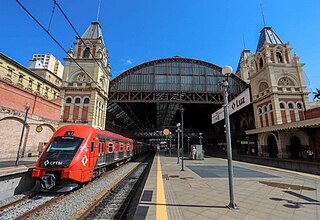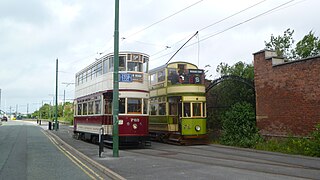
A tram is a type of urban rail transit consisting of rail vehicles, either individual railcars or self-propelled trains coupled into multiple units that run on tramway tracks on urban public streets; some include segments on segregated right-of-way. The tramlines or tram networks operated as public transport are called tramways or simply trams/streetcars. Trams are now commonly included in the wider term light rail, which also includes grade-separated segments of systems.

A heritage railway or heritage railroad is a railway operated as living history to re-create or preserve railway scenes of the past. Heritage railways are often old railway lines preserved in a state depicting a period in the history of rail transport.

Rail transport in New Zealand is an integral part of New Zealand's transport network, with a nationwide network of 4,375.5 km (2,718.8 mi) of track linking most major cities in the North and South Islands, connected by inter-island rail and road ferries. Rail transport in New Zealand has a particular focus on bulk freight exports and imports, with 19 million net tonnes moved by rail annually, accounting for more than half of rail revenue.
Brush Traction was a manufacturer and maintainer of railway locomotives in Loughborough, England whose operations have now been merged into the Wabtec company's Doncaster UK operations.

The Harz Narrow Gauge Railways is a railway company that operates a 1,000 mmmetre gauge network in the Harz mountains, in central Germany. The company was formed after the Second World War as a merger of two earlier companies. It owns about 140 kilometres of track, connecting the principal towns of Wernigerode, Nordhausen and Quedlinburg and several smaller settlements in the area. Much of the network is steeply graded and picturesque, but its most popular destination is the Brocken, the highest mountain in the region. The company runs a significant number of its trains with steam haulage, mostly employing 1950s vintage 2-10-2 tank locomotives, hauling traditional open-platform bogie carriages. The company is mainly owned by the various local authorities whose territories it serves.
Locomotives of New Zealand is a complete list of all locomotive classes that operate or have operated in New Zealand's railway network. It does not include locomotives used on bush tramways.

The Opua Branch or Otiria-Opua Industrial Line, partially still operational as the Bay of Islands Vintage Railway, is a former section of the North Auckland Line in the Northland Region of New Zealand, between Otiria and the Bay of Islands township of Opua. The first section was constructed as a bush tramway in 1867 and converted to a railway in the next decade. Today the railway is partially used by the Bay of Islands Vintage Railway, which runs tourist services between Kawakawa and Te Akeake. The line's centrepiece is the section where it runs down along the main street of Kawakawa.
Dick, Kerr and Company was a locomotive and tramcar manufacturer based in Kilmarnock, Scotland and Preston, England.
This list collects the transport-related vehicles exhibited or owned by the Museum of Transport and Technology (MOTAT) in Auckland, New Zealand.

Urban bus transport is the main form of public transport in New Zealand. Two of the country's largest cities, Auckland and Wellington, also have suburban rail systems, while some cities also operate local ferry services. There are no rapid transit metros and no remaining tram systems active anywhere in New Zealand, though trams once had a major role in New Zealand's public transport.

Trams in New Zealand were a major form of transport from the 19th century into the mid-20th century. New Zealand's first (horse) tramway was established in 1862 (Nelson), followed by a steam tramway in 1871 (Thames), and the first electric tramway in 1900. In New Zealand railway terminology a bush tramway is an industrial tramway, which usually did not carry passengers.

The Clogher Valley Railway was a 37-mile-long (60 km), 3 ft narrow gauge railway in County Tyrone and County Fermanagh, Northern Ireland. It opened in May 1887 and closed on 1 January 1942.

A & G Price Limited is an engineering firm and locomotive manufacturer in Thames, New Zealand founded in 1868.

Rail transport in Brazil began in the 19th century and there were many different railway companies. The railways were nationalized under RFFSA in 1957. Between 1999 and 2007, RFFSA was broken up and services are now operated by a variety of private and public operators, including Rumo Logística, Companhia Paulista de Trens Metropolitanos and SuperVia.

Wirral Tramway is a heritage tramway opened in 1995 by the Wirral Borough Council and Hamilton Quarter partnership and was operated by Blackpool Transport Services until 2005 when the council took over the licence to run the tramway.

Kawakawa railway station was a station on the Opua Branch in New Zealand. and is the terminus of the Bay of Islands Vintage Railway (BoIVR) in the small town of Kawakawa. It was also the terminus of the oldest railway on the North Island, opened in 1867, before being joined to the rest of the North Auckland Line in 1912.

Taumarere railway station was a station on the Opua Branch in New Zealand and is a stop on the Bay of Islands Vintage Railway near Taumarere village. It is on the oldest railway built on the North Island, which opened in 1867. Taumarere station has had three locations, east of the village, west of the village and at the rugby ground.

The first railway in Austria was the narrow-gauge line from Gmunden in the Salzkammergut to Budweis, now in the Czech Republic, this was 1,106 mm gauge. Some two dozen lines were built in 760 mm gauge, a few in 1,000 mmmetre gauge gauge. The first was the Steyrtalbahn. Others were built by provincial governments, some lines are still in common carrier use and a number of others are preservation projects. The tramway network in Innsbruck is also metre gauge; in Linz the rather unusual gauge of 900 mm is in use.

The Waro Limestone Scenic Reserve is a conservation area near Waro near Hikurangi, 16 kilometres (9.9 mi) north of Whangarei on the North Island of New Zealand.















